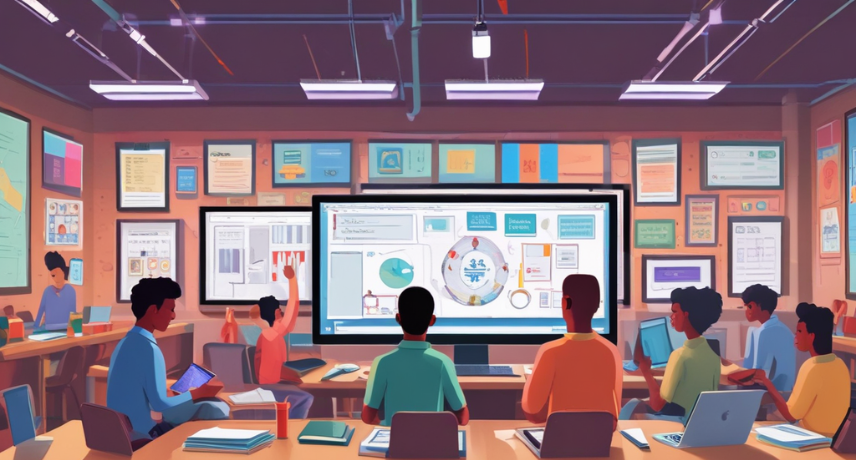Enquiry Form
What is Education Software?
Education Software is a category of digital tools designed to facilitate learning, teaching, administration, and collaboration in educational institutions. These applications cater to diverse needs such as student management, virtual classrooms, e-learning platforms, and assessment tools. By integrating advanced technologies like AI, AR/VR, and real-time analytics, education software enhances the learning experience, optimizes administrative processes, and promotes accessibility to quality education for students and educators alike.
Best Features of Education Software
Here are 15 key features of Education Software that make it indispensable for modern education systems:

Virtual Classrooms:
Enable real-time, interactive online learning with video conferencing and collaboration tools.

Learning Management System (LMS):
Provide centralized platforms for managing course materials, assignments, and student progress.

Student Information System (SIS):
Manage student records, including enrollment, attendance, grades, and schedules.

Gamified Learning:
Incorporate game-like elements to engage students and make learning more enjoyable.

Mobile Accessibility:
Offer mobile-friendly interfaces for learning anytime, anywhere.

E-Library Integration:
Provide access to digital resources like e-books, research papers, and journals.

Adaptive Learning:
Use AI to personalize learning paths based on individual student needs.

Assessment and Grading Tools:
Automate the creation, distribution, and grading of quizzes and exams.

Communication Tools:
Facilitate seamless interaction between students, teachers, and parents.

Attendance Tracking:
Simplify attendance recording and generate reports automatically.

Content Creation Tools:
Allow educators to design and share custom learning materials.

Data Analytics and Reporting:
Analyze student performance and generate actionable insights.

Parental Portals:
Keep parents informed about their child's progress and activities.

Multi-Language Support:
Cater to a global audience with support for multiple languages.

Secure Data Storage:
Ensure the protection of sensitive student and institutional data.
Benefits of Education Software
Education software offers transformative benefits for students, educators, and institutions:
- Enhanced Learning Outcomes: Personalize education to suit individual learning styles and needs.
- Improved Accessibility: Make quality education available to remote and underserved regions.
- Streamlined Administration: Reduce the workload of administrative tasks, allowing staff to focus on strategic goals.
- Increased Student Engagement: Use gamification, interactive content, and collaboration tools to keep students motivated.
- Cost Efficiency: Minimize infrastructure and resource costs with digital tools.
- Real-Time Progress Tracking: Provide instant feedback and insights into student performance.
- Scalability: Accommodate growing student populations and expand learning resources seamlessly.
- Collaboration and Communication: Foster better interaction between students, teachers, and parents.
Which Businesses Need Education Software?

Education software transforms traditional classrooms into modern learning environments.
- Interactive Lesson Plans: Enable teachers to create engaging and interactive lesson content.
- Automated Attendance: Streamline attendance management with automated tracking.
- Parental Engagement Tools: Provide parents with regular updates on student progress and activities.
- Secure Data Management: Store sensitive student information securely and accessibly.
- Customized Learning Paths: Help students progress at their own pace with personalized education plans.
- Classroom Collaboration: Facilitate group projects and discussions with digital tools.

Higher education institutions use software to optimize learning and administrative functions.
- Course Management Systems: Simplify the creation, organization, and distribution of course materials.
- Online Examinations: Conduct secure online exams with proctoring and automated grading.
- Research Collaboration: Provide tools for collaborative research and data sharing.
- Student Portals: Offer students access to schedules, grades, and resources in one place.
- Analytics for Institutional Growth: Analyze enrollment trends and academic performance to guide decision-making.
- Global Outreach: Attract international students with multi-language and multi-currency support.

E-learning platforms rely on education software to deliver quality online courses.
- Course Creation Tools: Enable instructors to design multimedia-rich courses.
- Subscription Management: Manage user subscriptions, payments, and renewals effortlessly.
- Mobile-First Solutions: Deliver learning content optimized for mobile devices.
- AI-Powered Insights: Personalize recommendations for courses and learning materials.
- Community Features: Foster peer-to-peer learning through forums and discussion boards.
- Content Monetization: Offer tools for instructors to sell their courses and track earnings.

Organizations use education software to train employees and upskill their workforce.
- Onboarding Programs: Simplify employee onboarding with structured training modules.
- Skill Assessment Tools: Measure employee skills and provide targeted improvement plans.
- Gamified Learning for Engagement: Incorporate challenges and rewards to make training enjoyable.
- Certifications and Badges: Award employees with certifications to recognize their achievements.
- Progress Tracking: Monitor employee development and ROI on training initiatives.
- Multi-Device Compatibility: Ensure training materials are accessible on desktops, tablets, and smartphones.

Non-profits leverage education software to deliver learning initiatives and outreach programs.
- Accessible Learning Content: Provide educational resources to underserved communities.
- Volunteer Training Tools: Prepare volunteers for programs with tailored training modules.
- Donation Management Integration: Streamline donor engagement and contributions.
- Impact Analytics: Track the success of educational campaigns with detailed reports.
- Remote Learning Features: Enable learning programs for geographically dispersed beneficiaries.
- Multimedia Content Delivery: Use videos, infographics, and quizzes to make learning engaging.
Best Education Software Solutions to Empower Learning & Teaching
Explore top education software tailored for schools, colleges, and e-learning platforms. Enhance learning outcomes, automate admin tasks, and create interactive learning experiences with the best education software solutions.
Latest News
Education Software FAQs
Here Are Some FAQs for Education Software






